A Bio-Inspired Drag Reduction Method of Bionic Fish Skin Mucus Structure
Abstract
1. Introduction
2. Materials and Methods
2.1. Materials and Sample Preparation
2.2. Drag Reduction Experiment
2.3. Numerical Simulation
3. Results and Analysis
3.1. Mucus Release Structure
3.2. Simulated Analysis
3.3. Experimental Analysis of Drag Reduction
4. Conclusions
- (1)
- A simulation analysis of mucous release on the surface of the structure was conducted using ANSYS Fluent 19.2. Under the conditions of a water flow velocity of 2 m/s and a mucous velocity of 0.3 m/s, the maximum drag reduction speed was observed to be approximately 15%. It is noteworthy that, with a fixed water flow velocity, the drag reduction effect exhibited an increasing trend, followed by a decrease as the mucous velocity increased.
- (2)
- This mucous release structure can control near-wall flow, reduce near-wall velocity gradients, and increase boundary layer thickness.
- (3)
- Flexible physical models of the mucous release structure were fabricated using PDMS, and the drag reduction performance was tested under different conditions, including bending angles, stretching levels, compression levels, and various water flow angles.
- (4)
- The drag reduction effect varied under different bending angles, with the optimal reduction achieved at a bending angle of 120°, reaching 20.56%. When the stretching level was within 10%, the mucous outflow gradually decreased, leading to a reduced drag reduction effect. Within a compression level of 10%, an increased compression level resulted in more mucous extrusion, leading to a better drag reduction effect. The drag reduction effect initially decreased and then increased with an increase in the water flow angle.
Author Contributions
Funding
Data Availability Statement
Conflicts of Interest
References
- Sindagi, S.; Vijayakunmar, R. Succinct review of MBDR/BDR technique in reducing ship’s drag. Ships Offshore Struct. 2021, 6, 968–979. [Google Scholar] [CrossRef]
- Scharnowski, S.; Bross, M.; Kähler, C.J. Accurate turbulence level estimations using PIV/PTV. Exp. Fluids 2019, 60, 1. [Google Scholar] [CrossRef]
- Mäkiharju, S.A.; Ceccio, S.L. On multi-point gas injection to form an air layer for frictional drag reduction. Ocean Eng. 2018, 147, 206–214. [Google Scholar] [CrossRef]
- Makiharju, S.; Elbing, B.R.; Wiggins, A.; Dowling, D.R.; Perlin, M.; Ceccio, S.L. Perturbed partial cavity drag reduction at high Reynolds numbers. In Proceedings of the 28th Symposium on Naval Hydrodynamics, Pasadena, CA, USA, 12–17 September 2010. [Google Scholar]
- Bixler, G.D.; Bhushan, B. Shark skin inspired low-drag microstructured surfaces in closed channel flow. J. Colloid Interface Sci. 2013, 393, 384–396. [Google Scholar] [CrossRef]
- Choi, K.S.; Yang, X.; Clayton, B.R.; Glover, E.J.; Atlar, M.; Semenov, B.N.; Kulik, V.M. Turbulent drag reduction using compliant surfaces. Proc. R. Soc. Lond. Ser. A 1997, 453, 2229–2240. [Google Scholar] [CrossRef]
- Zhang, D.; Li, Y.; Han, X.; Li, X.; Chen, H. High-precision bio-replication of synthetic drag reduction shark skin. Chin. Sci. Bull. 2011, 56, 938–944. [Google Scholar] [CrossRef]
- Chen, H.; Zhang, X.; Che, D.; Zhang, D.; Li, X.; Li, Y. Synthetic Effect of Vivid Shark Skin and Polymer Additive on Drag Reduction Reinforcement. Adv. Mech. Eng. 2014, 6, 425701. [Google Scholar] [CrossRef]
- Daniel, T.L. Fish mucus: In situ measurements of polymer drag reduction. Biol. Bull. 1981, 160, 376–382. [Google Scholar] [CrossRef]
- Tian, G.; Fan, D.; Feng, X.; Zhou, H. Thriving artificial underwater drag-reduction materials inspired from aquatic animals: Progresses and challenges. RSC Adv. 2021, 11, 3399–3428. [Google Scholar] [CrossRef] [PubMed]
- Yu, C.; Liu, M.; Zhang, C.; Yan, H.; Zhang, M.; Wu, Q.; Jiang, L. Bio-inspired drag reduction: From nature organisms to artificial functional surfaces. Giant 2020, 2, 100017. [Google Scholar] [CrossRef]
- Shephard, K.L. Functions for fish mucus. Rev. Fish Biol. Fish. 1994, 4, 401–429. [Google Scholar] [CrossRef]
- Rosen, M.W.; Cornford, N.E. Fluid friction of fish slimes. Nature 1971, 234, 49–51. [Google Scholar] [CrossRef]
- Tian, F.B. Hydrodynamic effects of mucus on swimming performance of an undulatory foil by using the DSD/SST method. Comput. Mech. 2020, 65, 751–761. [Google Scholar] [CrossRef]
- Choi, K.S. Drag reduction by riblets for marine applications. Trans. RINA 1991, 133, 269–282. [Google Scholar]
- Abubakar, A.; Al-Wahaibi, T.; Al-Wahaibi, Y.; Al-Hashmi, A.R.; Al-Ajmi, A. Roles of drag reducing polymers in single-and multi-phase flows. Chem. Eng. Res. Des. 2014, 92, 2153–2181. [Google Scholar] [CrossRef]
- Ayegba, P.O.; Edomwonyi-Otu, L.C.; Yusuf, N.; Abubakar, A. A review of drag reduction by additives in curved pipes for single-phase liquid and two-phase flows. Eng. Rep. 2021, 3, e12294. [Google Scholar] [CrossRef]
- Ayegba, P.O.; Edomwonyi-Otu, L.C.; Abubakar, A.; Yusuf, N. Drag Reduction for Single-Phase Water Flow in and around 180° Bends. J. Non-Newton. Fluid Mech. 2021, 295, 104596. [Google Scholar] [CrossRef]
- Ridgway, S.H.; Carder, D.A. Features of dolphin skin with potential hydrodynamic importance. IEEE Eng. Med. Biol. Mag. 1993, 12, 83–88. [Google Scholar] [CrossRef]
- Wu, L.; Wang, J.; Luo, G.; Wang, S.; Qu, J.; Fan, X.; Liu, C. Study on the drag reduction characteristics of the surface morphology of Paramisgurnus dabryanus loach. Coatings 2021, 11, 1357. [Google Scholar] [CrossRef]
- Chen, D.; Cui, X.; Chen, H. Dual-composite drag-reduction surface based on the multilayered structure and mechanical properties of tuna skin. Microsc. Res. Tech. 2021, 84, 1862–1872. [Google Scholar] [CrossRef]
- Rong, W.; Zhang, H.; Zhang, T.; Mao, Z.; Liu, X.; Song, K. Drag reduction using lubricant-impregnated anisotropic slippery surfaces inspired by bionic fish scale surfaces containing micro-/nanostructured arrays. Adv. Eng. Mater. 2021, 23, 2000821. [Google Scholar] [CrossRef]
- Li, L.; Zhu, J.; Li, J.; Song, H.; Zeng, Z.; Wang, G.; Xue, Q. Effect of vortex frictional drag reduction on ordered microstructures. Surf. Topogr. Metrol. Prop. 2019, 7, 025008. [Google Scholar] [CrossRef]
- Zheng, S.; Liang, X.; Li, J.; Liu, Y.; Tang, J. Drag reduction using bionic groove surface for underwater vehicles. Front. Bioeng. Biotechnol. 2023, 11, 1223691. [Google Scholar] [CrossRef] [PubMed]
- Dawson, M.; Wirtz, D.; Hanes, J. Enhanced Viscoelasticity of Human Cystic Fibrotic Sputum Correlates with Increasing Microheterogeneity in Particle Transport. J. Biol. Chem. 2003, 278, 50393–50401. [Google Scholar] [CrossRef]
- Zhou, H.; Shen, D.; Tian, G.; Cui, J.; Jia, C. Biomechanical characteristics of puffer skin for flexible surface drag reduction. Mech. Adv. Mater. Struct. 2021, 28, 1194–1200. [Google Scholar] [CrossRef]
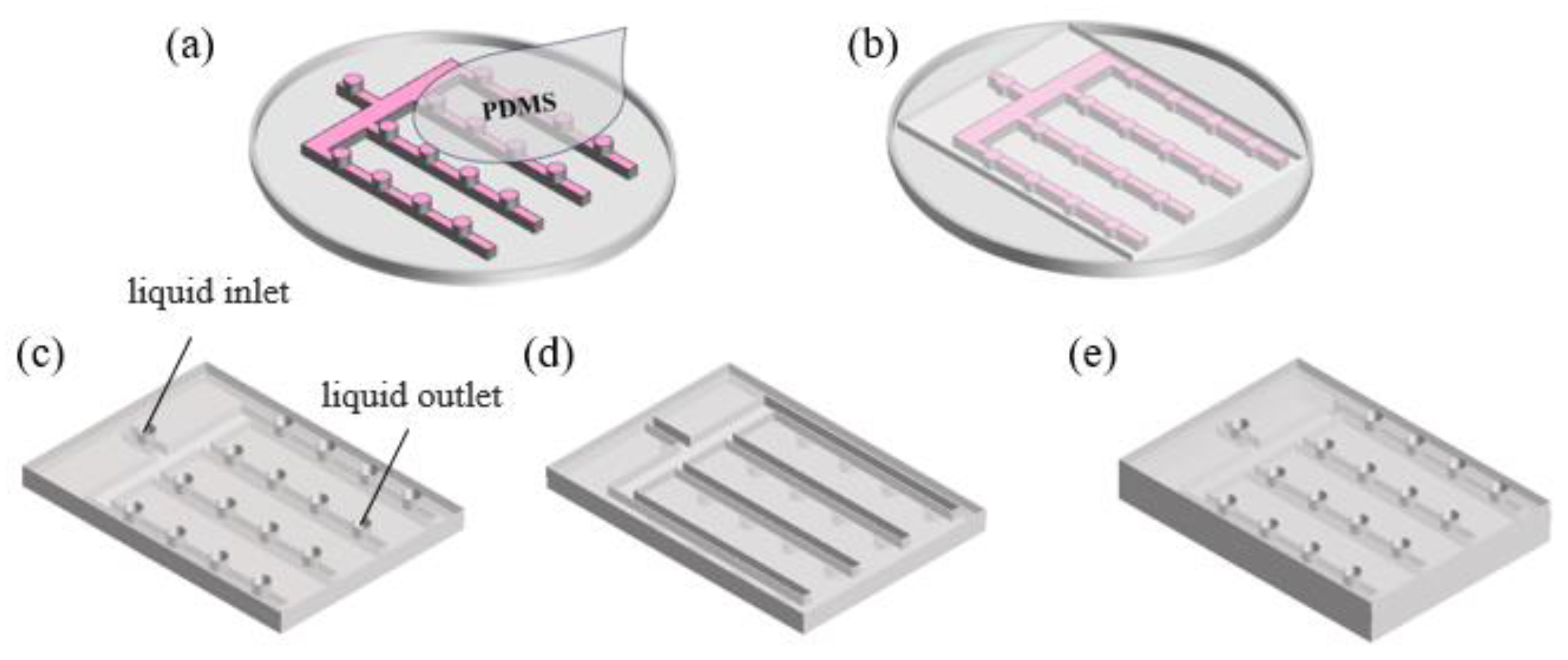
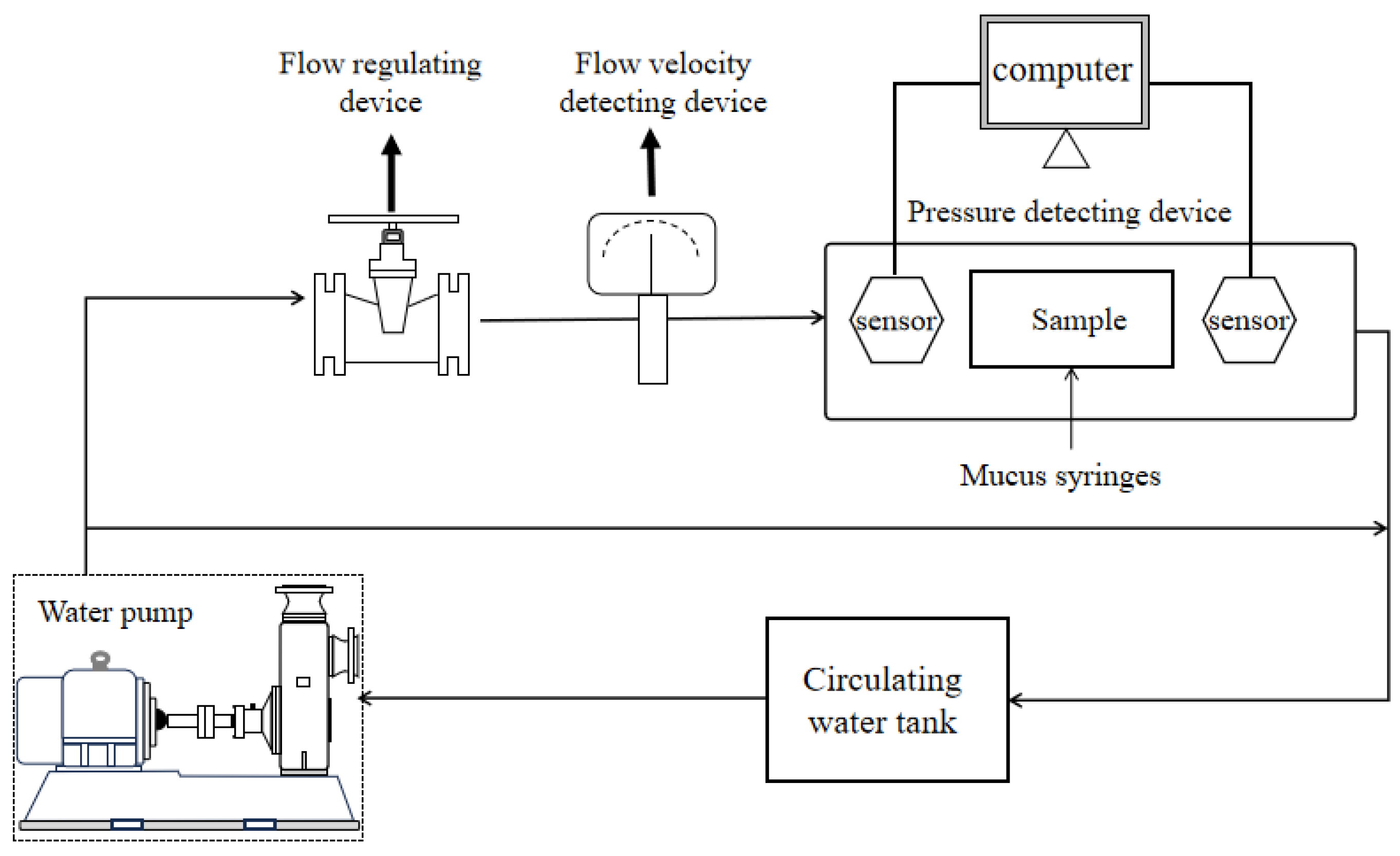


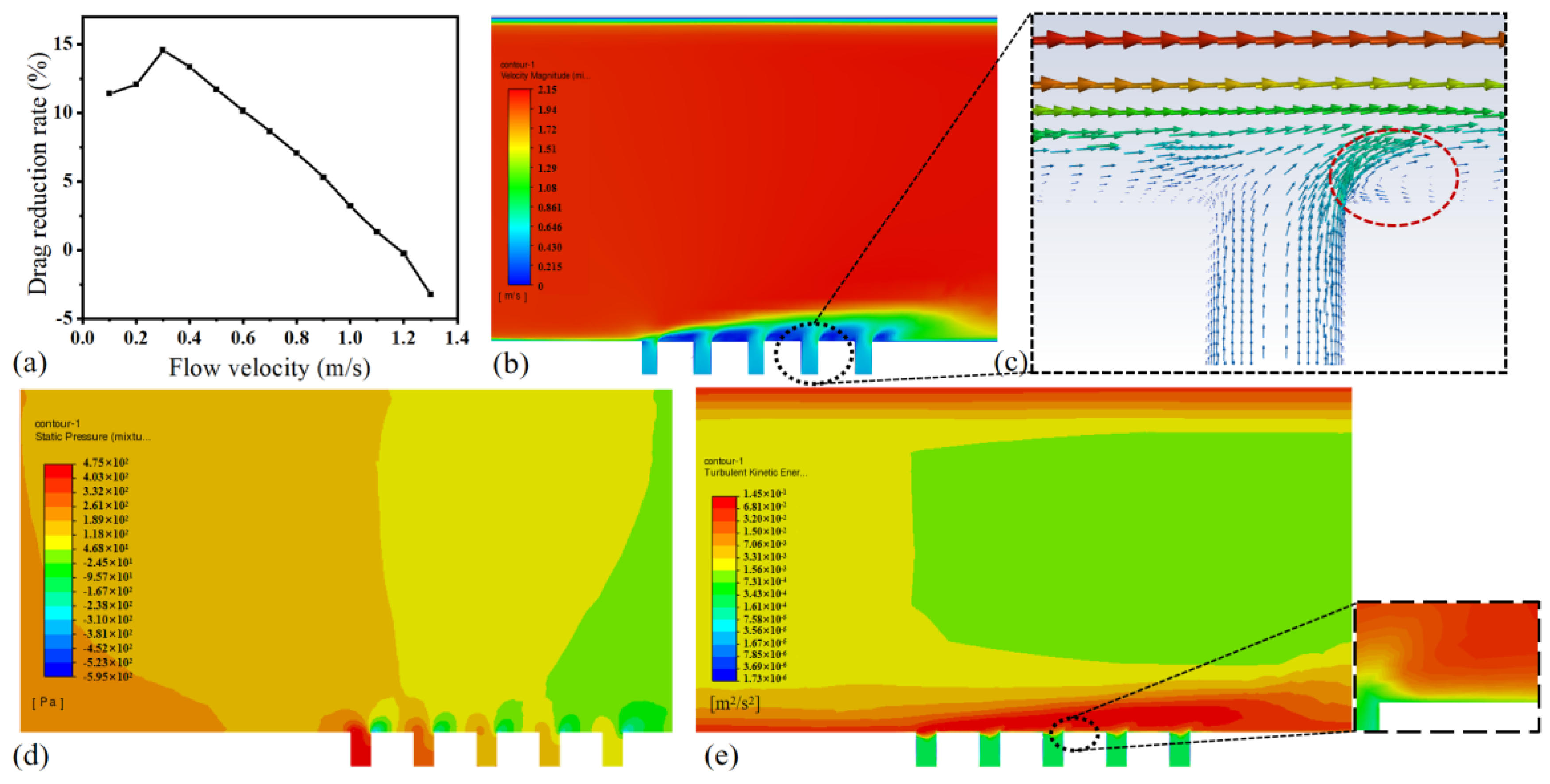
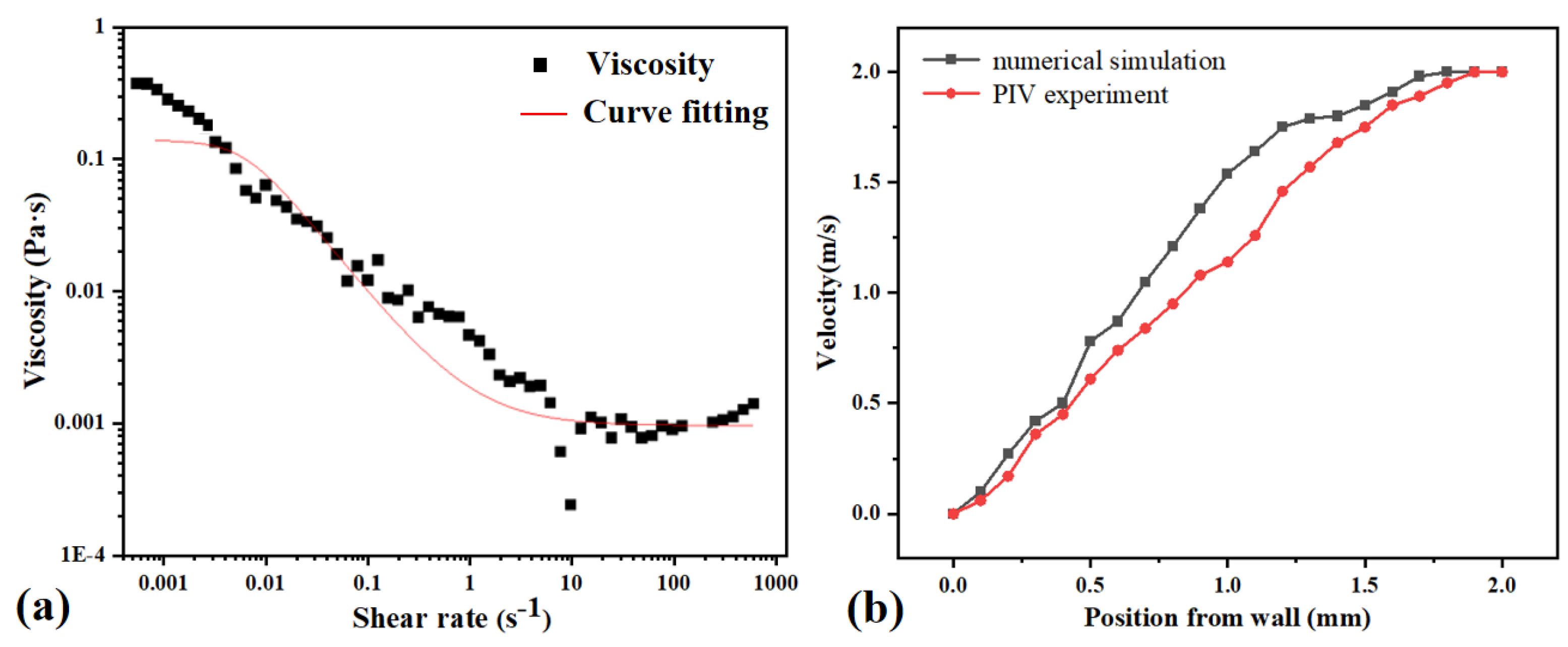
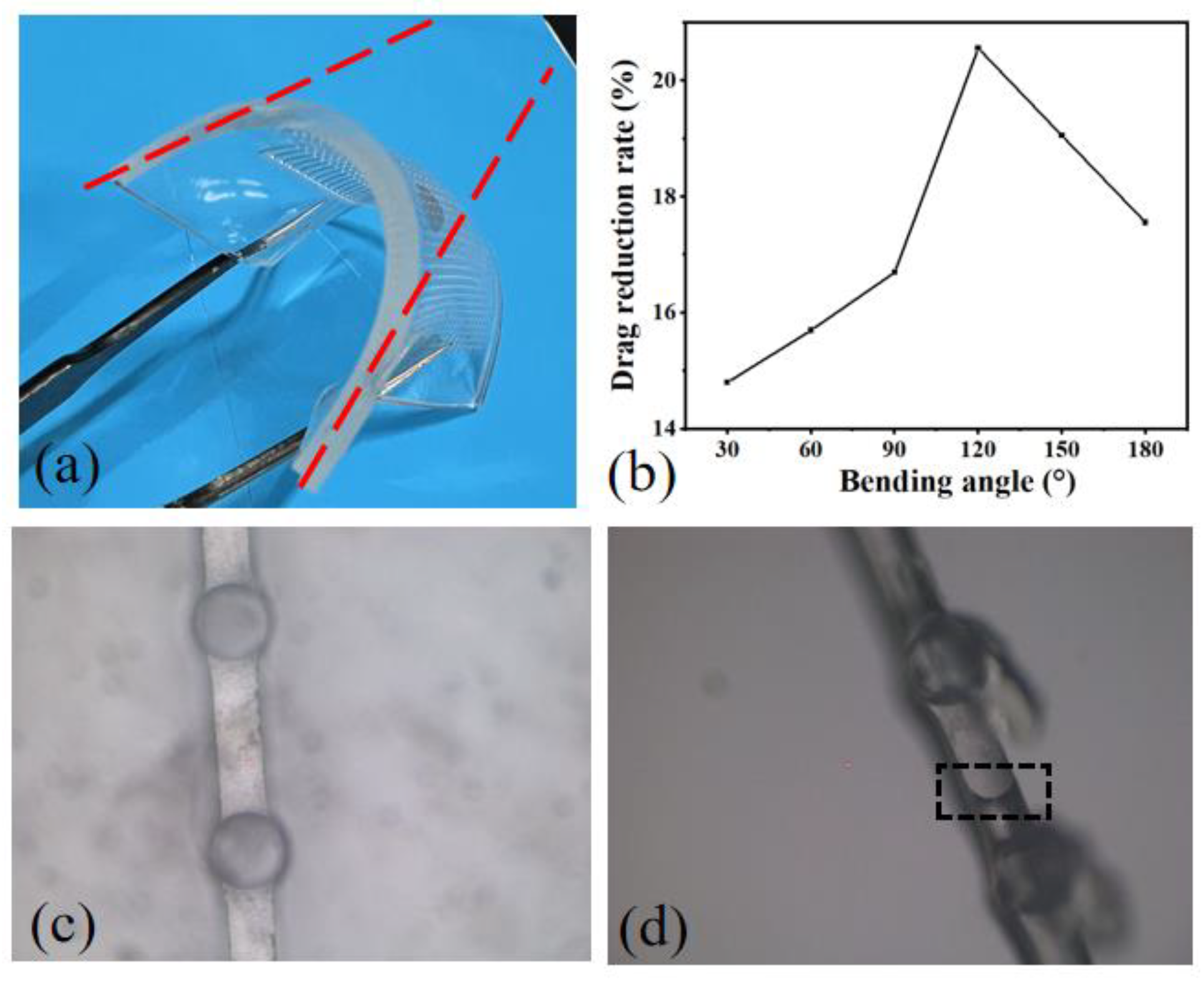



| Number of Grids (Ten Thousand) | Drag Coefficient Error | Strouhal Number Error |
|---|---|---|
| 25 | 1.4281% | 0.8% |
| 32 | 0.2462% | 0.04% |
| 43 | -- | -- |
Disclaimer/Publisher’s Note: The statements, opinions and data contained in all publications are solely those of the individual author(s) and contributor(s) and not of MDPI and/or the editor(s). MDPI and/or the editor(s) disclaim responsibility for any injury to people or property resulting from any ideas, methods, instructions or products referred to in the content. |
© 2024 by the authors. Licensee MDPI, Basel, Switzerland. This article is an open access article distributed under the terms and conditions of the Creative Commons Attribution (CC BY) license (https://creativecommons.org/licenses/by/4.0/).
Share and Cite
Zhao, P.; Li, X.; Luo, Z.; Zhai, Q.; Tian, Y.; Zhang, K.; Guo, H. A Bio-Inspired Drag Reduction Method of Bionic Fish Skin Mucus Structure. Micromachines 2024, 15, 364. https://doi.org/10.3390/mi15030364
Zhao P, Li X, Luo Z, Zhai Q, Tian Y, Zhang K, Guo H. A Bio-Inspired Drag Reduction Method of Bionic Fish Skin Mucus Structure. Micromachines. 2024; 15(3):364. https://doi.org/10.3390/mi15030364
Chicago/Turabian StyleZhao, Pengfei, Xin Li, Zhengjie Luo, Qihang Zhai, Ye Tian, Kaisheng Zhang, and Hao Guo. 2024. "A Bio-Inspired Drag Reduction Method of Bionic Fish Skin Mucus Structure" Micromachines 15, no. 3: 364. https://doi.org/10.3390/mi15030364
APA StyleZhao, P., Li, X., Luo, Z., Zhai, Q., Tian, Y., Zhang, K., & Guo, H. (2024). A Bio-Inspired Drag Reduction Method of Bionic Fish Skin Mucus Structure. Micromachines, 15(3), 364. https://doi.org/10.3390/mi15030364






